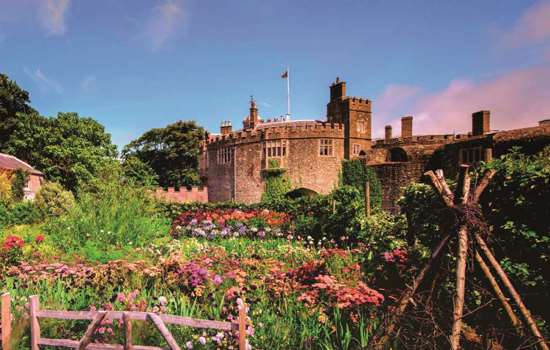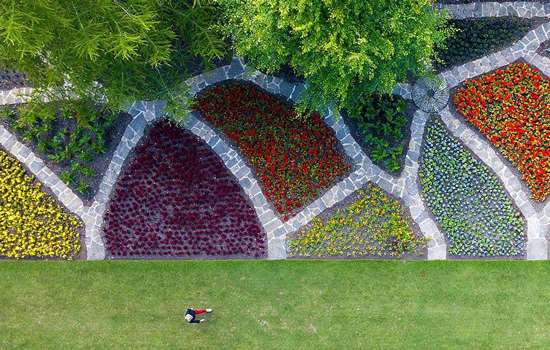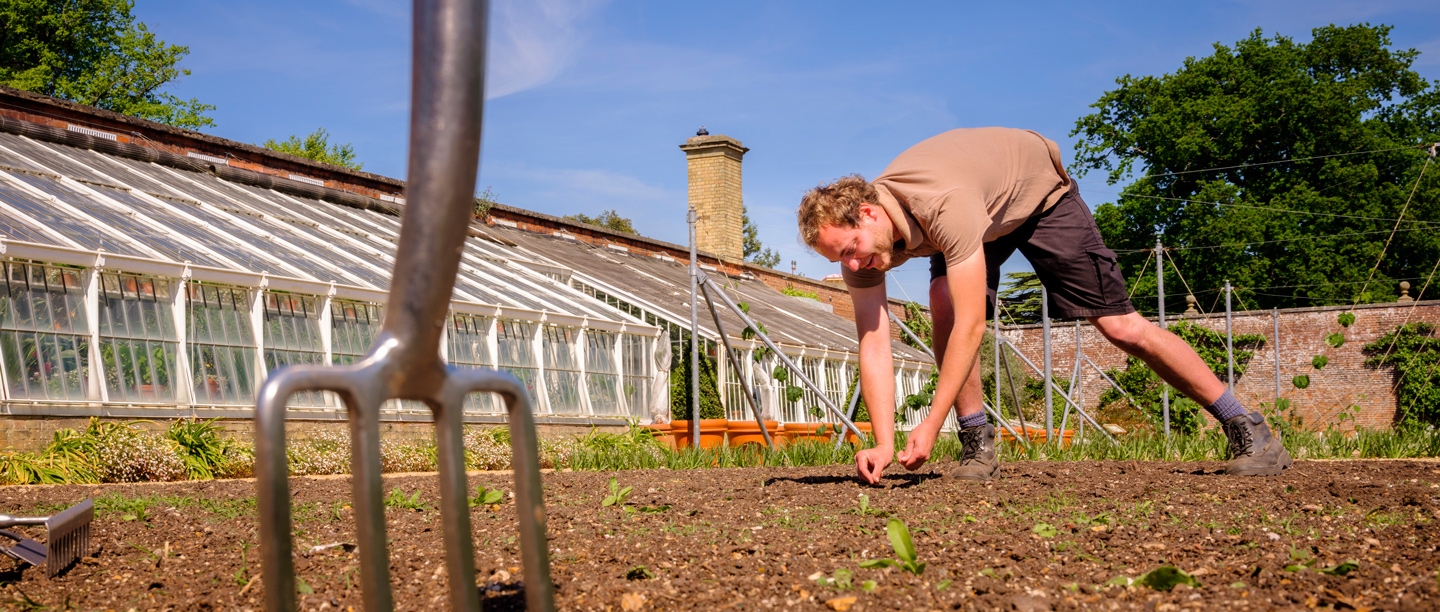Belsay Hall, Castle and Gardens, Northumberland
When Sir Charles Monck (1779–1867) built Belsay Hall in 1810–17, he created a new kitchen garden alongside the estate’s formal gardens. Sir Charles had an enquiring mind, especially in matters of modern technology, and this is particularly notable in the kitchen garden. He introduced a heated wall and a range of hothouses for growing exotic fruit, and also included specialist horticultural buildings such as a mushroom house and fig house.
In 1833 Sir Charles wrote to the Horticultural Society (later to become the Royal Horticultural Society) expounding on the advantages and disadvantages of the use of a heated wall in the cultivation of figs. He explained how he ‘last autumn took down the back wall and rebuilt it with a flue’, with the aim of allowing his gardener ‘the most perfect command of temperature’.
In 1829 the produce from the kitchen garden was being entered into horticultural competitions, which were a popular way of displaying expertise and innovation. One prize that Belsay took home from a local horticultural society was a bronze medal awarded for ‘six stalks of blanched rhubarb’.
Many of the kitchen garden buildings were demolished in the late 19th century, although the structure of the walled garden and heated wall survive. Today, the kitchen garden is no longer used to produce fruit and vegetables, although the view of the heated wall across the paddock is still an impressive sight.
Visit Belsay Hall, Castle and GardensAudley End House and Gardens, Essex
The kitchen garden at Audley End was moved to its current location in the 1750s and extended in 1768 by Sir John Griffin Griffin (1719–97). Accounts from the late 18th century include references to cucumber frames and melon beds and, throughout the 19th century, changes were made to the buildings to keep up with rapid horticultural advancements.
In 1860 a drawing of the Orchard House was published in a guide to orchard house design, revealing how Audley End was at the forefront of these horticultural innovations. The Vine House has been in place since before 1828 and the vines on display here are over 100 years old.
A diary documenting the daily life of gardener William Cresswell at Audley End in 1873 and 1874 was discovered in 1990 in a London flea market. The diary gives a fascinating insight into the daily tasks and concerns of a gardener in a kitchen garden in the 1870s. On Monday 20 July 1874 Cresswell describes his work: ‘Plums and large cherry (in pots) with fruit nearly ripe removed from orchard house to early vinery.’
An impressive range of fruit and vegetables is still grown in the garden today and all of it is put to use, either in Audley End’s restaurant or sold to other restaurants or box schemes.
Visit Audley End House and GardensHome of Charles Darwin – Down House, Kent
When Charles Darwin (1809–82) and his family moved to Down House, the kitchen garden was already in place. While writing On the Origin of Species in the 1850s, he took over a corner of it for his ‘experimental beds’, using them to investigate his theory of variation and natural selection. In the early 1860s Darwin erected a hothouse alongside the existing greenhouse in the kitchen garden, which he used as a laboratory for his experiments. Several of Darwin’s influential publications emerged from these, relating to the growth patterns and reproductive behaviour of plants.
Many of the vegetables grown in the kitchen garden today are Victorian varieties recorded by Darwin in his notebooks, while in the greenhouses you can see the same plants that Darwin cultivated for his research projects. Perhaps his greatest fascination was with insectivorous plants, especially Drosera rotundifolia – at the time his wife Emma mused that ‘he is treating Drosera just like a living creature and I suppose he hopes to end in proving it to be an animal’.
Visit Home of Charles Darwin – Down HouseOsborne, Isle of Wight
The walled kitchen garden at Osborne survives from the late-18th-century estate, before the arrival of the house’s most famous residents, Queen Victoria and Prince Albert.
By 1844 almost all the fruit and vegetables for the royal household were being provided by the new 27-acre kitchen garden at Frogmore next to Windsor Castle, and the development of the railways made it possible for fresh produce to be transported to Osborne when required. So while the mild climate of the island could be taken advantage of to grow unusual crops such as oranges, the remaining garden was planted with shrubs, herbaceous and annual plants to supply cut flowers and seasonal planting for the house.
In 1848 the original portico from the 18th-century house was reused to form the formal entrance to the kitchen garden. Two lean-to glasshouses, with service buildings behind, were erected in 1854 by Thomas Clark & Co of Birmingham on the south-facing wall of the garden for the display of exotic plants. Cold frames were used for the production of violets, a favourite of Queen Victoria’s, as they still are today.
The original cross-path pattern has been restored and a new garden was added in 2000, designed by Rupert Goldby. His design incorporates trained Victorian fruit trees, often with names linked to the royal couple, such as Lane’s Prince Albert apples and Victoria plums.
Visit OsborneWalmer Castle and Gardens, Kent
The area of land that now contains the kitchen garden at Walmer Castle in Kent has probably been a productive space for over 300 years, growing fruit, vegetables and flowers for the Lord Wardens of the Cinque Ports, whose official residence has been there since 1708. One of the glasshouses was constructed in 1898 and included a vinery, tomato house and small fernery, while a second glasshouse was added between 1936 and 1941. Particularly striking within the glasshouse today is the majestic bird of paradise flower (Strelitzia reginae).
Unusual varieties of fruit and vegetables are displayed in the garden in eye-catching patterns that change depending on the season. Beautifully trained fruit trees, mostly comprising traditional Kentish varieties, surround the planting beds, and an area of orchard contains three apple trees donated by the Worshipful Company of Fruiterers – one of which was planted by the Queen Mother.
The produce from the garden is used in the castle tea room, creating a fresh and seasonal menu. As part of our current project to open up new areas of Walmer Castle’s gardens with support of the National Lottery Heritage Fund, a new café has been created, providing a space to enjoy the kitchen garden whatever the season.
Visit Walmer Castle and GardensMore to explore
-

How to create a Walmer inspired garden
-
Make Gâteau de Pommes the Victorian Way
-

Find out more about our Historic Gardens

